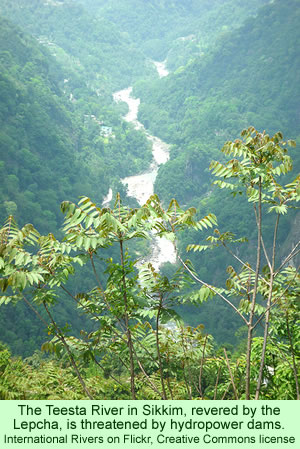The eminent journal Nature last Thursday featured the controversy over the construction of dams in the Teesta River valley, projects that many Lepchas passionately deplore. They feel that the dams are destroying their sacred landscape, but, as the article points out, government agencies are finding many reasons for moving ahead with the construction.
 Jane Qiu, the author, points out that India has built, or is planning to build, about 300 dams in the headwater streams of the Himalayas. The reason is that the country wants to continue its rapid economic growth, for which it needs more and more electric power, according to dam proponents. A massive power blackout this past July, when about 600 million people, half of the country, lost their electricity for days, is being cited by dam advocates as a symptom of the problem.
Jane Qiu, the author, points out that India has built, or is planning to build, about 300 dams in the headwater streams of the Himalayas. The reason is that the country wants to continue its rapid economic growth, for which it needs more and more electric power, according to dam proponents. A massive power blackout this past July, when about 600 million people, half of the country, lost their electricity for days, is being cited by dam advocates as a symptom of the problem.
The controversy flared up two weeks ago in Sikkim, where the Lepcha and Bhutia peoples renewed their protests, which have been ongoing in the state for many years. Over 1,300 opponents of the latest dam, a 520 megawatt project called Teesta IV, have signed a petition protesting the construction of any more dams on the Teesta River.
A conservation biologist at the University of Massachusetts, Boston, Kamaljit Bawa, criticized the Indian government’s handling of the dam projects. “The magnitude of dam building in the Himalayas is overwhelming,” he said. “They are moving too fast without properly assessing the risks and alternatives.”
Proponents of the dams argue they are an essential phase of the nation’s goal to double its electricity output in ten years. Advocates for more power dams point out that the nation is the third worst emitter of carbon dioxide in the world, the result of all its coal-fired power plants. If the nation doesn’t find alternative sources of energy, India’s emissions of greenhouses gases will double by 2030. As a result, the government plans to build enough dams to deliver eight times as much hydropower by 2025 as the nation has now.
A scientific study published recently points out that the result of such planning will be a massive network of dams across the Himalayan River valleys, one for every 3,000 square kilometers, or 62 times the global average. Maharaj Pandit, from the University of Delhi and the lead author of the study, says that the consequences of such a proliferation of dams “would be dire.” His report argues that the mountain valleys are high in biodiversity, much of which would be affected by the reservoirs.
Unlike dams in broad river valleys, which create huge reservoirs in order to gain heads of water for power generation, these projects in the mountains tend to have small reservoirs and rely on tunnels to carry water down to generating stations below. Therefore, proponents argue, not much flora and fauna is disrupted by their minimal footprints. Opponents disagree. Pandit argues that they still harm fish migrations and aquatic ecosystems.
Another opponent, Dulal Goswami, a scientist at Gauhati University, feels that the geological problems in the region are not being properly considered in the rush to build the dams. Earthquakes are common in the mountains, and the increase of glacial melting due to global warming is causing more flooding. Both sources of instability threaten the dam structures.
A conservationist in the city of Pune, Neeraj Vagholikar, argues that the Environmental Impact Assessments required by Indian law are lax. For one dam, the EIA listed just five bird species that might be impacted in an area that scientists contend has 300. The EIA for another dam listed 55 species of fish in a river that has, in fact, over 156. Furthermore, the EIAs only assess the immediate areas of the dams and ignore the downstream effects.
Samir Mehta, an official with International Rivers, an NGO in California that has become involved with trying to protect the Himalayan river systems, says the assessments are so poorly done that 99 percent of the projects get routinely approved, despite the problems noted by scientists.
Mehta points out that the assessments are not done in an appropriate manner. The firms that conduct them are paid by the dam developers, who clearly want favorable reports, so the assessors make sure the EIAs are positive in order to insure that they will be invited back to conduct more.
The article in Nature focuses mostly on scientific and bureaucratic reasoning and does not go into a major aspect of the opposition by the Lepcha people. To them, the dams threaten what they feel is sacred landscape, especially in the Dzongu Reserve, which preserves one of the major tributaries of the Teesta.